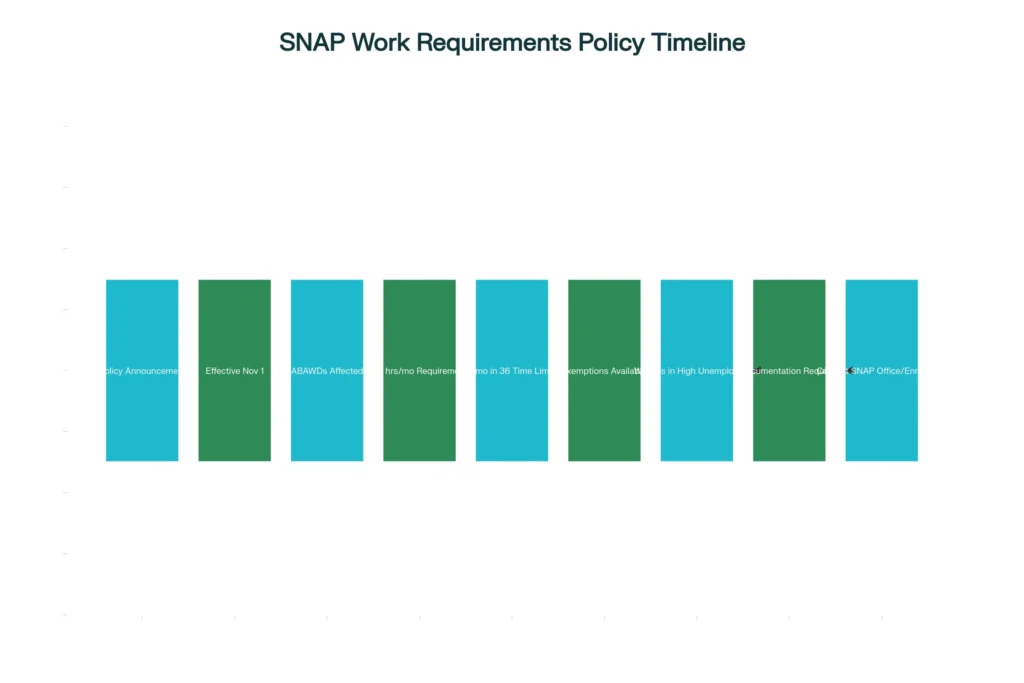If you rely on SNAP, here’s the bottom line: nationwide SNAP work requirements for able-bodied adults without dependents begin full enforcement on November 1, with tighter screening, fewer waivers, and clearer verification standards under this year’s federal guidance and law changes. To keep benefits beyond three months in a 36‑month window, most ABAWDs will need to document at least 80 hours per month of work, approved training, or workfare, unless they qualify for an exemption.

This is the shift from policy updates to enforcement. States will apply the 80‑hours‑per‑month standard for ABAWDs, narrow time‑limit waivers to strict labor‑market criteria, and verify exemptions more rigorously, so documentation matters. If you’re unsure where you stand, contact your local office, ask about SNAP Employment & Training options, and line up proof of hours to avoid hitting the three‑months‑in‑36 limit.
Table of Contents
Nationwide SNAP Work
If you fall under ABAWD rules, plan to document 80 hours in November, verify any exemptions or local waivers, and keep records organized the combination of narrowed waivers, closer verification, and the end of the transition window makes preparation essential. Staying proactive with your SNAP office is the simplest way to protect eligibility as enforcement begins. November 1 marks the start of stricter, nationwide enforcement of SNAP work requirements for able-bodied adults without dependents, centered on meeting about 80 hours per month of work, training, or workfare to avoid the three-month limit within a 36‑month period, unless an exemption applies. Practical success now hinges on two things knowing your status and documenting it: confirm whether you’re an ABAWD, check if an area waiver or personal exemption applies, and keep pay stubs, employer letters, and program attendance logs ready.
What Changes on November 1
- ABAWD time‑limit enforcement goes uniform: meet 80 hours monthly of countable activities or face the three‑months‑in‑36 limit, unless exempt.
- Waiver flexibility narrows: waivers hinge on 10%+ unemployment or an insufficient‑jobs finding; they pause the time limit, not general work rules.
- Verification tightens: expect closer screening and proof requirements; keep pay stubs, employer letters, and attendance logs.
Who Must Meet The Rules, Who Is Exempt
- Primary group: ABAWDs under the updated age definitions are the focus for time‑limit enforcement, while most 16–59 who can work remain under general work rules unless exempt.
- Exemptions: children, seniors, veterans, people experiencing homelessness, certain former foster youth, pregnant individuals, and those with verified health limitations may be exempt from the ABAWD time limit.
- Students: half‑time college students have separate, strict eligibility; specific exemptions are required to qualify.

How To Meet the SNAP Work Requirements November 1
- Countable activities: combine paid work, approved education or training, and workfare to reach 80 hours monthly; SNAP E&T can help meet the requirement.
- Documentation: organize proof now pay stubs, employer statements, class or program attendance logs, workfare records to prevent interruptions.
- Missed months: falling short without an exemption triggers the three‑months‑in‑36 limit until you re‑qualify or become exempt.
What States and Counties Will Do Differently
- Notices and screening: agencies must notify impacted households, screen for exemptions, and verify hours more consistently.
- Quality control: the hold‑harmless window tied to new ABAWD rules ends with November; error accountability resumes.
- Local administration: counties that administer SNAP will issue guidance and handle case actions; watch local updates closely.
Waivers And Local Labor Conditions
- Area waivers: possible only in areas with high unemployment or insufficient jobs per federal standards; they affect the time limit, not general work rules.
- Transparency: USDA posts waiver materials and status updates, making it easier to check your county’s coverage.
- Practical check: ask your agency if your county has an active ABAWD time‑limit waiver before assuming one applies.
Practical Steps to Stay Compliant
- Confirm your category: verify whether you’re an ABAWD and whether any area waiver or personal exemption applies.
- Line up hours: plan schedules, enroll in E&T, and blend approved activities to reach 80 hours each month; avoid quitting or reducing hours without good cause.
- Keep records handy: timely proof prevents denials or gaps when enforcement starts.
$1000 Cash App Payment Incoming? Check Your Eligibility for the Class Action Settlement
Important Context for November
- Some outlets report possible SNAP issuance disruptions tied to funding disputes; payment timing is separate from work‑rule enforcement, so prepare regardless.
- Additional USDA guidance is expected as 2025 changes roll through, especially on exceptions and waiver criteria; stay tuned to state communications.
- If unsure, contact your SNAP office now waiting until after a cutoff risk hitting the three‑month limit.
SNAP Employment & Training or combine eligible activities to reliably reach the 80‑hour mark. If you believe you’re exempt—for medical reasons, pregnancy, veteran status, homelessness, or other listed categories—submit documentation early to prevent gaps. Finally, monitor your state or local office updates: even if benefit schedules fluctuate due to separate funding issues, work-rule enforcement continues, and being prepared is the best way to protect your eligibility.

















